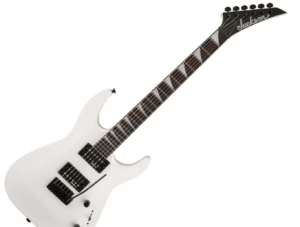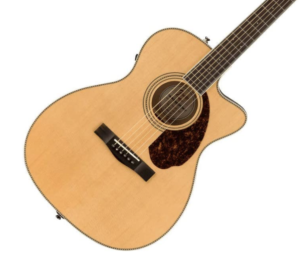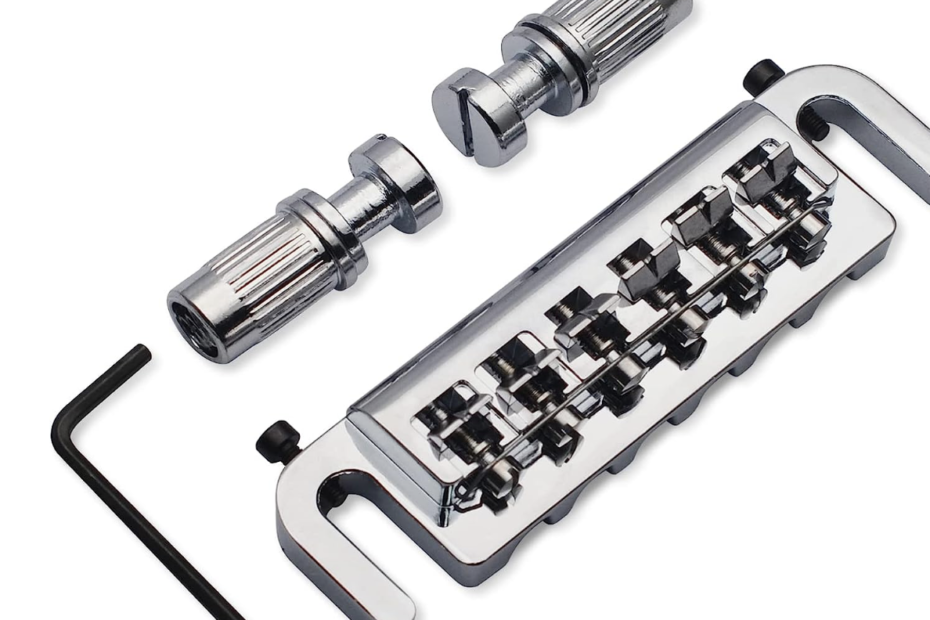 A guitar bridge is a component found on the body of a guitar that holds and anchors the strings. It is a critical part of the instrument’s design and functionality. The bridge serves multiple purposes, including setting the string height (action), determining the string length (scale length), transmitting string vibrations to the guitar body, and allowing for the adjustment of intonation.
A guitar bridge is a component found on the body of a guitar that holds and anchors the strings. It is a critical part of the instrument’s design and functionality. The bridge serves multiple purposes, including setting the string height (action), determining the string length (scale length), transmitting string vibrations to the guitar body, and allowing for the adjustment of intonation.
The bridge is typically located near the lower end of the guitar body, opposite the neck. Its primary function is to hold the strings in place and provide a point of contact for their vibration. The strings pass over or through the bridge, and their tension is controlled by bridge saddles or other mechanisms.
There are various types of guitar bridges, each with its own design, features, and characteristics. Some common types include fixed bridges (also known as hardtail bridges), tremolo bridges (which allow for pitch bending and vibrato effects), and floating bridges (such as the Floyd Rose system). The choice of bridge type can significantly affect the playability, tuning stability, and sound of the guitar.
In addition to their functional role, guitar bridges can also contribute to the instrument’s aesthetics. They come in different shapes, materials, and finishes, and can be a visually distinctive feature of a guitar.
The guitar bridge plays a crucial role in determining how the strings feel and sound, as well as how well the instrument stays in tune. It is an essential component that requires proper setup and maintenance to ensure optimal performance and playability.
Also Read:
Epiphone Acoustic Guitar Models: Classic Sound with a Contemporary Twist
Guitar Strings Breaking: How to Avoid the Destruction of Strings
Electric Parts on Guitar Fetish
10 Types of Guitar Bridges
 Here are the 10 most used guitar bridges on the market.
Here are the 10 most used guitar bridges on the market.
- Fixed Bridge (Hardtail)
- Tremolo Bridge (Floating or Floating Tremolo)
- Floyd Rose Bridge
- Tune-o-Matic Bridge
- Vintage-style Synchronized Tremolo Bridge
- Wilkinson/Gotoh Bridge
- Bigsby Vibrato Tailpiece
- Hipshot Bridge
- PRS Tremolo Bridge
- Rickenbacker “R” Tailpiece
Fixed Bridge (Hardtail)
 The fixed bridge, also known as a hardtail bridge, is a type of guitar bridge that offers simplicity, stability, and reliable performance. It is a popular choice among guitarists who prefer a solid and secure connection between the strings and the guitar body. Here are some key features and characteristics of the fixed bridge:
The fixed bridge, also known as a hardtail bridge, is a type of guitar bridge that offers simplicity, stability, and reliable performance. It is a popular choice among guitarists who prefer a solid and secure connection between the strings and the guitar body. Here are some key features and characteristics of the fixed bridge:
The fixed bridge typically allows for individual string height adjustments through the use of height-adjustable saddles. This feature allows players to set the desired string action according to their playing style and preferences. However, compared to other bridge types, the range of action adjustment may be more limited.
Fixed bridges generally provide some degree of intonation adjustment. This enables players to fine-tune the pitch accuracy of each string to ensure proper intonation across the fretboard. Intonation adjustment is crucial for maintaining accurate pitch and ensuring that chords and melodies sound in tune.
One of the primary advantages of a fixed bridge is its inherent stability. Once the strings are properly set up and locked in place, they remain stable and maintain their tuning well, even with aggressive playing or bending techniques. The absence of a floating bridge system reduces the likelihood of tuning issues caused by string tension changes.
Unlike floating bridges or tremolo systems, fixed bridges do not provide built-in vibrato effects or the ability to perform dramatic pitch bends. However, some players appreciate the increased tuning stability and solid feel that a fixed bridge offers, making it suitable for styles that don’t require extensive use of vibrato or extreme pitch manipulation.
 With a fixed bridge, changing strings is relatively straightforward. Each string typically has its own saddle, and the strings are usually anchored through the body or bridge plate. This makes string changes quick and convenient compared to bridges with more complex setups.
With a fixed bridge, changing strings is relatively straightforward. Each string typically has its own saddle, and the strings are usually anchored through the body or bridge plate. This makes string changes quick and convenient compared to bridges with more complex setups.
The fixed bridge enhances the transfer of string vibrations to the guitar body, allowing for good sustain and resonance. The lack of moving parts or springs in the bridge contributes to a solid and direct connection between the strings and the guitar, resulting in a focused and well-defined tone.
Fixed bridges are known for their simplicity and reliability. They require minimal maintenance and adjustment, making them a convenient choice for guitarists who prefer a “set it and forget it” approach. The absence of complex mechanisms reduces the risk of mechanical failures or complications during live performances.
Here are a few examples of guitars that feature a fixed bridge (hardtail):
- Fender Telecaster – The iconic Telecaster model is available with a hardtail bridge option, offering a solid and stable platform for string attachment.
- Gibson Les Paul Studio – The Les Paul Studio model from Gibson often comes with a fixed bridge configuration, providing excellent sustain and tuning stability.
- PRS SE Custom 24 – Some versions of the PRS SE Custom 24 feature a hardtail bridge, delivering a straightforward and reliable setup for players who prefer a fixed bridge.
- Ibanez RG Hardtail – The Ibanez RG series offers hardtail versions of their popular models, providing a durable and solid bridge system for players seeking stability and simplicity.
- Schecter Solo-II Custom – Schecter’s Solo-II Custom guitar is available with a fixed bridge option, offering precise intonation adjustment and enhanced string-to-body transfer for increased sustain.
- ESP LTD EC-1000 – The ESP LTD EC-1000 series includes models with a fixed bridge setup, delivering solid tuning stability and a focused tone for rock and metal players.
- Gretsch G2622 Streamliner – The Streamliner series from Gretsch offers semi-hollowbody guitars with a fixed bridge option, combining vintage aesthetics with reliable performance.
- Yamaha Pacifica 112V – The Yamaha Pacifica 112V is a versatile electric guitar that features a fixed bridge, making it an excellent choice for beginners and players who prefer simplicity.
- Jackson JS Series – The Jackson JS Series guitars offer hardtail versions, providing a solid foundation for aggressive playing styles and a sleek look.
- Epiphone Les Paul Standard – Some models of the Epiphone Les Paul Standard feature a fixed bridge, offering the classic Les Paul design and tone with added tuning stability.
Tremolo Bridge (Floating or Floating Tremolo)
 A tremolo bridge, also known as a floating tremolo or simply a tremolo system, is a type of guitar bridge that allows players to manipulate the pitch of the strings by raising or lowering the bridge. It is a popular choice among guitarists who enjoy creating expressive pitch variations and dive bombs.
A tremolo bridge, also known as a floating tremolo or simply a tremolo system, is a type of guitar bridge that allows players to manipulate the pitch of the strings by raising or lowering the bridge. It is a popular choice among guitarists who enjoy creating expressive pitch variations and dive bombs.
Here are some key features and characteristics of a tremolo bridge:
- Floating Design: Tremolo bridges are designed to “float” above the guitar body, allowing the player to both raise and lower the pitch of the strings using the tremolo arm (also known as a whammy bar or vibrato arm).
- Spring System: Tremolo bridges typically incorporate a spring system that counterbalances the tension of the strings. The springs are connected to the bridge and the guitar body, creating a balance between the string tension and the spring tension.
- Tremolo Arm: The tremolo arm is attached to the bridge and allows the player to manipulate the pitch of the strings. By pushing or pulling on the arm, the player can create subtle vibrato, wide pitch bends, or extreme dive bombs.
- Floating Effect: One of the distinctive characteristics of a floating tremolo bridge is its ability to produce an upward or downward pitch shift. By pulling up on the tremolo arm, the strings are loosened, resulting in a higher pitch. Conversely, pushing down on the arm increases the string tension and lowers the pitch.
- String Tension Adjustment: Tremolo bridges often have adjustable screws or springs that allow the player to adjust the overall tension of the bridge. This adjustment helps maintain stability and proper intonation.
- Diving and Pulling Up: With a tremolo bridge, players can perform techniques such as dive bombs, where the pitch rapidly drops, or pull-ups, where the pitch is raised. These techniques can add dynamic and dramatic effects to guitar playing.
- String Stability and Tuning: While a floating tremolo bridge allows for expressive playing, it can also introduce some challenges in terms of string stability and tuning. Changes in string tension caused by using the tremolo arm can affect the overall tuning of the guitar. Proper setup, including proper string stretching and bridge adjustment, is crucial for maintaining stability and accurate tuning.
Some popular tremolo bridge systems include the Floyd Rose, Wilkinson, Ibanez Edge, and Fender Floating Tremolo (as found on Stratocaster models). These systems vary in design and functionality, but they all offer the ability to create expressive pitch variations.
Tremolo bridges are commonly found on electric guitars, particularly in genres such as rock, blues, and metal, where players frequently incorporate dive bombs and other tremolo techniques into their playing. They provide a unique playing experience and open up a wide range of creative possibilities for guitarists.
Examples of tremolo bridge systems
 Here are some examples of popular tremolo bridge systems:
Here are some examples of popular tremolo bridge systems:
- Floyd Rose: The Floyd Rose is one of the most well-known and widely used tremolo systems. It features a double-locking design, allowing for precise tuning stability even with aggressive tremolo use. It is commonly found on guitars from brands like Ibanez, Jackson, and ESP.
- Wilkinson/Gotoh: Wilkinson and Gotoh produce high-quality tremolo bridges known for their smooth operation and reliable tuning stability. These bridges are often found on guitars from various manufacturers, including Fender and Charvel.
- Ibanez Edge/Edge Pro: Ibanez’s Edge and Edge Pro tremolo systems are renowned for their excellent tuning stability and smooth operation. These bridges are commonly featured on Ibanez electric guitars, especially those designed for shredding and high-performance playing.
- Fender Floating Tremolo: Fender’s vintage-style floating tremolo, also known as the Synchronized Tremolo, is a staple on their Stratocaster models. It offers a classic tremolo feel and is known for its smooth operation and subtle pitch modulation.
- PRS Tremolo: PRS guitars often feature their own proprietary tremolo bridge system. PRS tremolos are known for their excellent tuning stability, smooth action, and refined design. They are commonly found on PRS Custom 24 and Custom 22 models.
- Schaller Floyd Rose: Schaller produces high-quality Floyd Rose tremolo systems that offer reliable tuning stability and precise adjustment options. They are commonly used as aftermarket upgrades or featured on guitars from various manufacturers.
- Kahler Tremolo: Kahler tremolo bridges have a distinctive design with a rear-mounted spring system. They provide a smooth and responsive tremolo action, along with solid tuning stability. Kahler bridges are often seen on guitars used in rock and metal genres.
- Music Man Floating Tremolo: Music Man guitars, including the popular John Petrucci signature models, feature their own floating tremolo system. It offers precise tuning stability and smooth operation for expressive playing.
- PRS Floyd Rose: PRS also offers models with Floyd Rose tremolo systems, combining the renowned stability of Floyd Rose with PRS’s own design touches. These bridges provide precise tuning control and enhanced sustain.
Comparing the Different Guitar Bridges
Here’s a table outlining the features of each guitar bridge along with a rating scale from 1 to 5 for each feature:
| Guitar Bridge | Action Adjustability | Intonation Adjustability | Stability | Vibrato Effects | String Changing Ease |
|---|---|---|---|---|---|
| Fixed Bridge (Hardtail) | 3 | 5 | 5 | 1 | 5 |
| Tremolo Bridge | 4 | 4 | 3 | 5 | 3 |
| Floyd Rose Bridge | 5 | 5 | 5 | 5 | 2 |
| Tune-o-Matic Bridge | 4 | 5 | 4 | 1 | 4 |
| Vintage-style Synchronized Tremolo Bridge | 3 | 3 | 2 | 4 | 3 |
| Wilkinson/Gotoh Bridge | 4 | 4 | 4 | 2 | 4 |
| Bigsby Vibrato Tailpiece | 3 | 3 | 3 | 4 | 3 |
| Hipshot Bridge | 5 | 4 | 5 | 1 | 5 |
| PRS Tremolo Bridge | 4 | 5 | 4 | 3 | 4 |
| Rickenbacker “R” Tailpiece | 2 | 2 | 3 | 1 | 5 |
Note: The scale ranges from 1 (low) to 5 (high), with higher numbers indicating better performance or features in that particular category.
